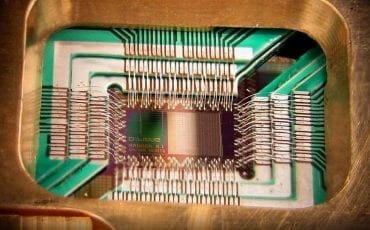Quantum entanglement is a physical phenomenon that occurs when pairs or groups of particles generate or interact in ways such that the quantum state of each particle cannot be described independently of the others. This is true even when the particles are separated by a large distance. A quantum state must instead be described for the system as a whole.
Measurements of physical properties such as position, momentum, spin, and polarization, performed on entangled particles establish appropriate correlation among them. For example, let’s assume a pair of particles generate in such a way that their total spin is zero. Further, let’s say one particle has a clockwise spin on a certain axis. Then, due to entanglement, the spin of the other particle, measured on the same axis, is counterclockwise.
This behavior, however, gives rise to paradoxical effects. Any measurement of a property of a particle can be seen as acting on that particle (e.g., by collapsing a number of superposed states). The measurement changes the original quantum property by some unknown amount. In the case of entangled particles, such a measurement is on the entangled system as a whole. Therefore, it appears that one particle of an entangled pair “knows” what measurement has been performed on the other, and with what outcome. This is true even though there are no known means of communicating such information between the particles. And, even when the particles are at an arbitrarily enormous distance away from each other at the time of measurement.
Entanglement measures quantify, the amount of entanglement in aquantum state (often viewed as a bipartite). Entanglement entropy is the standard measure of entanglement for pure states (but not a measure of entanglement for mixed states). For mixed states, there are some entanglement measures in the literature and no single one is standard.
- Entanglement cost
- Distillable entanglement
- Entanglement of formation
- Relative entropy of entanglement
- Squashed entanglement
- Logarithmic negativity
Most (not all) of these entanglement measures reduce for pure states to entanglement entropy and are difficult (NP-hard) to compute.
Applications of Entanglement
Entanglement finds many applications in quantum information theory. Entanglement makes otherwise impossible tasks achievable.
Some of the most widely known entanglement applications include superdense coding and quantum teleportation.
Most researchers believe that entanglement is necessary to realize quantum computing (although others dispute this).
Some protocols of quantum cryptography use entanglement. The reason is the “shared noise” of entanglement is an excellent one-time pad. Further, because measurement of any one of the particles of the entangled pair results in immediate breakdown of the entanglement, cryptography based on entanglement of quantum particles can help instantly detect any mala fide interception to the transmission.
In interferometry, entanglement is necessary for surpassing the standard quantum limit and achieving the Heisenberg limit.
Methods of Creating Entanglement
Entanglement usually takes place due to direct interactions between subatomic particles. These interactions can take numerous forms. One of the most commonly used methods is spontaneous parametric down-conversion to generate a pair of photons entangled in polarization. Other methods include the use of a fiber coupler to confine and mix photons, the use of quantum dots to trap electrons until decay occurs, the use of the Hong-Ou-Mandel effect, and so on. In the earliest tests of Bell’s theorem, atomic cascades generated the entangled particles.
It is also possible to create entanglement between quantum systems that never directly interact, through the use of entanglement swapping.
Entanglement Swapping
Teleportation is equally applicable to the pure states as well as the mixed states. A mixed state can be regarded as the state of a single subsystem of an entangled pair. A good example is entanglement swapping.
Assume that Alice has a particle entangled with a particle that Bob owns. Bob teleports his particle to Carol. Consequently, Alice’s particle gets entangled with Carol’s particle.
A more symmetric way to describe the situation is the following: Alice has one particle, Bob two, and Carol one. Alice’s particle is entangled with the first particle Bob has; similarly, Bob’s second particle is entangled with Carol’s particle.
As per the teleportation scheme described above, the state of Bob’s first particle can be teleported to Carol’s. Even without Alice and Carol ever interacting, their particles get entangled.
Testing a System for Entanglement
Systems containing no entanglement are said to be separable. For 2-Qubit (2×2) and Qubit-Qutrit (2×3) systems, the simple Peres–Horodecki criterion provides a necessary and sufficient criterion for separability. This enables detecting entanglement. For the general case, however, the criterion is merely a sufficient one for separability, as the problem becomes NP-hard. Jon Magne Leinaas, Jan Myrheim and Eirik Ovrum in their paper “Geometrical aspects of entanglement” suggest a numerical approach to the problem. Leinaas et al. offer a numerical approach wherein an estimated separable state is iteratively refined towards the target state, which is to be tested. It is also checked if it is possible to reach the target state. An implementation of the algorithm (including a built-in Peres-Horodecki criterion testing) is in the “StateSeparator” web-app.
In 2016, China launched the world’s first quantum communications satellite: “China has launched the world’s first satellite dedicated to testing the fundamentals of quantum communication in space. The $100m Quantum Experiments at Space Scale (QUESS) mission was launched on Aug 16, 2016 from the Jiuquan Satellite Launch Center in northern China at 01:40 local time. For the next two years, the craft – also named “Micius” after the ancient Chinese philosopher – will demonstrate the feasibility of quantum communication between Earth and space, and test quantum entanglement over unprecedented distances.”
Paradox
The paradox is that a measurement made on either of the particles collapses the state of the entire entangled system. And, it happens instantaneously, before any information about the measurement result could have been communicated to the other particle (assuming that information cannot travel faster than light) and hence assured the “proper” outcome of the measurement of the other part of the entangled pair.
In the quantum formalism, if the measurement of spin is performed on a particle of the entangled pair, the system collapses into a state in wherein each particle possesses a definite up or down spin along the axis of measurement. The probability of each spin is 50%. If both spins, instead, are measured along the same axis, they are discovered to be anti-correlated. This means that when a measurement is made on one particle, the random outcome is immediately transmitted to the other particle. This other particle then makes the “right choice” when measurement is done on it as well.
The distance between the entangled particles can be made so humongous and the timing of the measurements can be so short so that the interval between making the two measurements is on the scale of space. This implies that information exchange between entangled pairs has to happen at a speed faster than light. And, this, according to the principles of special relativity, is impossible. In fact, we also cannot be certain as to which measurement was first made. For two spacelike separated events x1 and x2, there are inertial frames wherein either x1 or x2 is first. Therefore, the correlation between the two measurements is not straight forward in that the one determines other. To different observers, different measurements would fit in the role of being the cause and the effect.
In conclusion, the result shows it is theoretically impossible to determine a particle’s properties by measuring the other’s properties.
Hidden Variables Theory
A possible resolution to the paradox is to assume that quantum theory is incomplete, and the result of measurements depends on predetermined “hidden variables.” The state of the particles being measured contains some hidden variables. It is the values of these hidden variables that determine the spin measurement outcomes. This means all the required information is carried by each particle. Also, nothing needs to be transmitted from one particle to the other at the time of measurement.
Among certain other scientists, Einstein originally believed this as the only way out of the paradox. In addition, the accepted quantum mechanical description (with a random measurement outcome) must be incomplete. In fact, even without the presence of entanglement, such paradoxes can exist. The position of a single particle is spread out over space, and two detectors, separated by a great distance, that attempt to detect the particle in two different places (where these individual detectors are placed) must make an instant correlation to ensure that both of them do not detect the particle.
Violations of Bell’s Inequality
All predictions of quantum mechanics can never be reproduced by any physical theory of local hidden variables.
The fundamental issue in measuring spin along different axes is that the measurements cannot have definite values at the same time. The uncertainty principle constrains the maximum precision in measurements. This is contrary to classical physics principle, wherein a large number of properties are simultaneously measurable with arbitrary accuracy. It’s proven mathematically that compatible measurements cannot show Bell-inequality-violating correlations, and thus entanglement is a fundamentally non-classical phenomenon.
Other Experiments
In experiments conducted in 2012 and 2013, polarization correlation was created between photons that never coexisted in time. The authors claimed that this result was achieved by entanglement swapping between two pairs of entangled photons. This was done after measuring the polarization of one photon of the early pair. This proves that quantum non-locality applies not only to space but also to time.
In 2013, three independent experiments showed that classically communicated separable quantum states can be used to carry entangled states. The first loophole-free Bell test was conducted in TU Delft in 2015 confirming the violation of Bell inequality.
In August 2014, Brazilian researcher Gabriela Barreto Lemos and team “took pictures” of objects using photons that did not interact with the subjects, but were entangled with photons that interacted with such objects. Lemos, from the University of Vienna, is confident this new quantum imaging technique is applicable where low-light imaging is imperative. Examples include fields such as biological or medical imaging.
Mystery of Time
There have been suggestions to view the concept of time as an emergent phenomenon that is a side effect of quantum entanglement. Per these views, time has its roots in entanglement and that it places all equal clock readings (of precisely manufactured clocks or any such equivalent time-measuring equipment) into the same history. Page and Wootters argued that entanglement can be used to measure time.
In 2013, at the Istituto Nazionale di Ricerca Metrologica (INRIM) in Turin, Italy, researchers performed the first experimental test of Page and Wootters’ ideas. Their result has been interpreted to confirm that time is an emergent phenomenon for internal observers but absent for external observers of the universe just as the Wheeler-DeWitt equation predicts.
Non-locality and Entanglement
Generally, media meant for the consumption of a wide section of audience often portrays quantum non-locality and entanglement as equivalent. While it is true that a pure bipartite quantum state must be entangled in order for it to produce non-local correlations, there exist entangled states that do not produce such correlations. Also, there exist non-entangled (separable) quantum states that present some non-local behavior. A well-known example of the first case is the Werner state that is entangled for certain values, but can always be described using local hidden variables. Therefore, for a state to be non-local, entanglement of this two-party state is necessary but not sufficient. Moreover, it was shown that, for an arbitrary number of parties, there exist states that are genuinely entangled but admits a fully local strategy.
It is important to recognize that entanglement is more commonly viewed as an algebraic concept, noted for being a precedent to non-locality as well as to quantum teleportation and to superdense coding. As against this, non-locality is defined according to experimental statistics and is much more involved with the foundations and interpretations of quantum mechanics.
Learn more: https://amyxinternetofthings.com/



